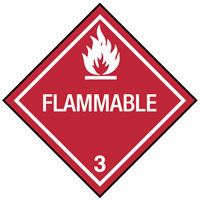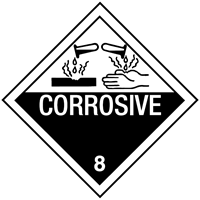
 Print
Print
Chemical Datasheet
METHYLAMINE, AQUEOUS SOLUTION |


|
Chemical Identifiers
| CAS Number |
UN/NA Number |
DOT Hazard Label |
USCG CHRIS Code |
- 74-89-5

|
|
- Flammable Liquid
- Corrosive
|
|
| NIOSH Pocket Guide |
International Chem Safety Card |
|
Methylamine
|
- METHYLAMINE
- METHYLAMINE (40% aqueous solution)
|
NFPA 704
General Description
A colorless to yellow aqueous solution of a gas. Odor ranges from fishlike to ammonia-like as the vapor concentration increases. Flash point (of 30% solution) 34°F. Corrosive to skin and eyes. Less dense than water; vapors heavier than air. Produces toxic oxides of nitrogen during combustion.
Hazards
Reactivity Alerts
Air & Water Reactions
Highly flammable. Water soluble.
Fire Hazard
Special Hazards of Combustion Products: Toxic nitrogen oxides may be formed.
Behavior in Fire: Vapors are heavier than air and may travel a considerable distance to a source of ignition and flashback. When heated to decomposition, it emits toxic fumes of NO X (USCG, 1999)
Health Hazard
INHALATION: Causes irritation of nose and throat, followed by violent sneezing, burning sensation in throat, coughing and difficulty in breathing, pulmonary congestion, edema of the lungs and conjunctivitis. Bronchitis occurred in a worker exposed to a workroom concentration range of 2-60 ppm. EYES: Liquid contact causes burning (severe exposure may cause blindness). SKIN: Causes burning. Vapors may cause dermatitis. INGESTION: Causes burns of the mouth, throat and esophagus. (USCG, 1999)
Reactivity Profile
A basic solution. Neutralizes acids to form salts plus water. These acid-base reactions are exothermic. The amount of heat that is evolved per mole of amine in a neutralization is largely independent of the strength of the amine as a base. May be incompatible with isocyanates, halogenated organics, peroxides, phenols (acidic), epoxides, anhydrides, and acid halides. It initiates detonation of nitromethane.
Belongs to the Following Reactive Group(s)
- Amines, Phosphines, and Pyridines
- Water and Aqueous Solutions
Potentially Incompatible Absorbents
Use caution: Liquids with this reactive group classification have been
known to react with the
absorbent
listed below.
- Mineral-Based & Clay-Based Absorbents
Response Recommendations
Isolation and Evacuation
Excerpt from ERG Guide 132 [Flammable Liquids - Corrosive]:
IMMEDIATE PRECAUTIONARY MEASURE: Isolate spill or leak area for at least 50 meters (150 feet) in all directions.
SPILL: Increase the immediate precautionary measure distance, in the downwind direction, as necessary.
FIRE: If tank, rail tank car or highway tank is involved in a fire, ISOLATE for 800 meters (1/2 mile) in all directions; also, consider initial evacuation for 800 meters (1/2 mile) in all directions. (ERG, 2024)
Firefighting
Excerpt from ERG Guide 132 [Flammable Liquids - Corrosive]:
Some of these materials may react violently with water.
SMALL FIRE: Dry chemical, CO2, water spray or alcohol-resistant foam.
LARGE FIRE: Water spray, fog or alcohol-resistant foam. If it can be done safely, move undamaged containers away from the area around the fire. Dike runoff from fire control for later disposal. Do not get water inside containers.
FIRE INVOLVING TANKS, RAIL TANK CARS OR HIGHWAY TANKS: Fight fire from maximum distance or use unmanned master stream devices or monitor nozzles. Cool containers with flooding quantities of water until well after fire is out. Withdraw immediately in case of rising sound from venting safety devices or discoloration of tank. ALWAYS stay away from tanks in direct contact with flames. For massive fire, use unmanned master stream devices or monitor nozzles; if this is impossible, withdraw from area and let fire burn. (ERG, 2024)
Non-Fire Response
Excerpt from ERG Guide 132 [Flammable Liquids - Corrosive]:
ELIMINATE all ignition sources (no smoking, flares, sparks or flames) from immediate area. All equipment used when handling the product must be grounded. Do not touch or walk through spilled material. Stop leak if you can do it without risk. Prevent entry into waterways, sewers, basements or confined areas. A vapor-suppressing foam may be used to reduce vapors. Absorb with earth, sand or other non-combustible material. For hydrazine, absorb with DRY sand or inert absorbent (vermiculite or absorbent pads). Use clean, non-sparking tools to collect absorbed material.
LARGE SPILL: Dike far ahead of liquid spill for later disposal. Water spray may reduce vapor, but may not prevent ignition in closed spaces. (ERG, 2024)
Protective Clothing
Self-contained (positive pressure, if available) breathing apparatus and full protective clothing. No skin surface should be exposed. (USCG, 1999)
DuPont Tychem® Suit Fabrics
Normalized Breakthrough Times (in Minutes)
| Chemical |
CAS Number |
State |
QS |
QC |
SL |
C3 |
TF |
TP |
RC |
TK |
RF |
| Methyl amine (40%) |
74-89-5 |
Liquid |
|
|
|
140 |
|
|
261 |
261 |
261 |
| Methyl amine (50%) |
74-89-5 |
Liquid |
|
|
|
|
|
|
232 |
232 |
232 |
| Methyl amine (gaseous) |
74-89-5 |
Vapor |
|
|
|
|
>480 |
>480 |
105 |
>480 |
105 |
Special Warning from DuPont: Tychem® and Tyvek® fabrics should not be
used around heat, flames, sparks or in potentially flammable or
explosive environments. Only...
(DuPont, 2024)
First Aid
INHALATION: Remove victim to fresh air at once. If breathing is difficult, give oxygen. If breathing has stopped, give artificial respiration. Get medical attention.
EYES: Flush with water for at least 15 minutes. Physician should examine eyes if irritation or pain persists after 15 minutes.
SKIN: Exposed area should be washed twice with soap and water. Physician should examine exposed area if pain or irritation persist after area is washed.
INGESTION: Do not induce vomiting or perform gastric lavage. Do not attempt to neutralize. Dilute with water or milk in copious amounts. (USCG, 1999)
Physical Properties
Flash Point:
32°F
(USCG, 1999)
Lower Explosive Limit (LEL):
4.3 %
(USCG, 1999)
Upper Explosive Limit (UEL):
21 %
(USCG, 1999)
Autoignition Temperature:
806°F
(USCG, 1999)
Melting Point:
-134.5°F
(USCG, 1999)
Vapor Pressure: data unavailable
Vapor Density (Relative to Air): data unavailable
Specific Gravity: data unavailable
Boiling Point:
20.66°F
at 760 mmHg
(USCG, 1999)
Molecular Weight:
31.06
(USCG, 1999)
Water Solubility: data unavailable
Ionization Energy/Potential:
8.97 eV
[From NPG: Methylamine]
(NIOSH, 2024)
IDLH:
100 ppm
[From NPG: Methylamine]
(NIOSH, 2024)
AEGLs (Acute Exposure Guideline Levels)
Interim AEGLs for Methyl amine (74-89-5)
| Exposure Period |
AEGL-1 |
AEGL-2 |
AEGL-3 |
| 10 minutes |
15 ppm |
160 ppm |
910 ppm |
| 30 minutes |
15 ppm |
92 ppm |
510 ppm |
| 60 minutes |
15 ppm |
64 ppm |
350 ppm |
| 4 hours |
15 ppm |
31 ppm |
170 ppm |
| 8 hours |
15 ppm |
21 ppm |
110 ppm |
(NAC/NRC, 2024)
ERPGs (Emergency Response Planning Guidelines)
| Chemical |
ERPG-1 |
ERPG-2 |
ERPG-3 |
| Monomethylamine (74-89-5)
|
4 ppm  |
20 ppm |
60 ppm |
(AIHA, 2022)
PACs (Protective Action Criteria)
| Chemical |
PAC-1 |
PAC-2 |
PAC-3 |
|
| Monomethylamine; (Methylamine) (74-89-5)
|
15 ppm |
64 ppm |
350 ppm |
LEL = 49000 ppm |
(DOE, 2024)
Regulatory Information
EPA Consolidated List of Lists
| Regulatory Name |
CAS Number/
313 Category Code |
EPCRA 302
EHS TPQ |
EPCRA 304
EHS RQ |
CERCLA RQ |
EPCRA 313
TRI |
RCRA
Code |
CAA 112(r)
RMP TQ |
| Methanamine |
74-89-5 |
|
|
100 pounds |
|
|
10000 pounds |
| Monomethylamine |
74-89-5 |
|
|
100 pounds |
|
|
10000 pounds |
(EPA List of Lists, 2024)
CISA Chemical Facility Anti-Terrorism Standards (CFATS)
|
RELEASE |
THEFT |
SABOTAGE |
| Chemical of Interest |
CAS Number |
Min Conc |
STQ |
Security
Issue |
Min Conc |
STQ |
Security
Issue |
Min Conc |
STQ |
Security
Issue |
| Methylamine; [Methanamine] |
74-89-5 |
1.00 % |
10000 pounds |
flammable |
|
|
|
|
|
|
(CISA, 2007)
OSHA Process Safety Management (PSM) Standard List
| Chemical Name |
CAS Number |
Threshold Quantity (TQ) |
| Methylamine, Anhydrous |
74-89-5 |
1000 pounds |
(OSHA, 2019)
Alternate Chemical Names
- AMINOMETHANE
- CARBINAMINE
- MERCURIALIN
- METHANAMINE
- METHYLAMINE
- METHYLAMINE (AQUEOUS)
- METHYLAMINE SOLUTION
- METHYLAMINE, AQUEOUS SOLUTION
- METHYLAMINE, [AQUEOUS SOLUTION]
- MMA
- MONOMETHYLAMINE



 Print
Print

